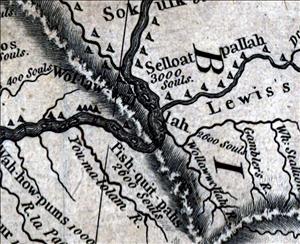On July 9, 1811, at the mouth of the Snake River where it joins the Columbia, Canadian explorer David Thompson (1770-1857) erects a pole with a sign claiming the surrounding country for Great Britain. Thompson also leaves a British flag with the Wallula Indians, who control the area. The sign and flag are a statement to the American fur traders of John Jacob Astor's Pacific Fur Company, who are competing with Thompson's North West Company of Canada, then still a British colony. The British claim does not prevail: the confluence of the Snake and Columbia now marks the intersection of Benton, Franklin, and Walla Walla counties in Washington.
Thompson, a fur trader, surveyor, and mapmaker, headed the Columbia Department of the North West Company. In 1807, he established a trading outpost on a river flowing north from Lake Windermere in present day British Columbia. Neither Thompson nor other explorers knew at the time that this was the Columbia, which flows north for several hundred miles before turning south through Washington to the Pacific Ocean. Although European and American ships had been visiting the mouth of the Columbia since 1792, and although the Lewis and Clark expedition had traveled and mapped the Columbia from the mouth of the Snake to the ocean in 1805 and 1806, no non-Indian had traveled the many miles of the Columbia between the Snake and its source near Lake Windermere.
With the news of Lewis and Clark’s exploration of the Columbia, and with the U.S.-Canadian boundary disputed by Britain and the United States, the North West Company sought to establish its influence in the Columbia River region before American fur traders reached the area. Probably because it was flowing in the wrong direction, Thompson did not travel downstream on the Columbia, but instead followed the nearby Kootenai River south into present day Montana and Idaho. By 1809 he reached and explored the Pend Oreille River in northeastern Washington’s Pend Oreille County, and in 1810, North West Company traders under his direction established Spokane House near the present site of the city of Spokane.
Claiming the Country
In 1811, Thompson set off from Spokane House in an effort to reach the mouth of the Columbia ahead of land and sea parties dispatched by John Jacob Astor (1763–1848). Reaching the river at Kettle Falls in present Stevens and Ferry Counties, he and his party of seven men built a canoe. They traveled rapidly down the swift waters of the Columbia, stopping to meet and smoke with all the Indian groups they saw along the way, in order to establish good relations with them.
On July 9, 1811, Thompson’s canoe reached the junction with the Snake River, which he called the Shawpatin. That day Thompson wrote in his journal:
"Here I erected a small Pole with a half sheet of Paper well tied about it, with these words on it: Know hereby that this Country is claimed by Great Britain as part of it’s [sic] Territories and that the NW Company of Merchants from Canada, finding the Factory for this People inconvenient for them, do hereby intend to erect a Factory in this Place for the Commerce of the Country around" (Thompson, 152).
Later that day, a few miles downstream, Thompson met with Yellepit, a leader of the Walula tribe. Yellepit had an American flag and a medal of Thomas Jefferson that he had received from Lewis and Clark. Thompson must have given the Walula a British flag, because when the Astorian fur traders reached the Columbia-Snake junction a month later, they reported "waving triumphantly in the air, at the confluence of the two great branches ... a British flag, hoisted in the middle of the Indian camp, planted there by Mr. Thompson ..." (Nisbet, 226). Thompson and Yellepit discussed future trade arrangements, and agreed that the North West Company would build a "factory" or trading post at the mouth of the Snake.
Beaten By the Astorians
Thompson continued down the Columbia River but was too late to beat the Astorians. Astor’s ship, the Tonquin, reached the mouth of the Columbia in April. By the time Thompson’s canoe arrived on July 15, 1811, the Americans had established a post, which they named Astoria. The founding of Astoria, along with the fact that American Captain Robert Gray (1755-1806) had beaten British ships into the Columbia in 1792, strengthened America’s claim to the Columbia region.
The North West Company never built a post at the mouth of the Snake River. Although the Canadian company actually took control of Astoria for several years during the War of 1812, and the British flag continued to fly over North West Company and Hudson’s Bay Company outposts in what is now Washington for many more years, the claim that Thompson made for Great Britain on July 9, 1811, did not prevail. Nevertheless, Thompson, who later that year returned up the Columbia from Kettle Falls, became the first non-Indian to travel the hundreds of miles of the Columbia between its source and the mouth of the Snake River.

